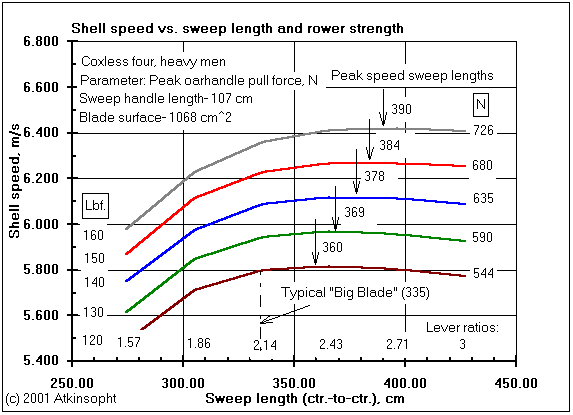Cast a vote here if you think it should move up in the Top-100 ranking:

You will be transferred to the Top-100 site, but may then return here by going "BACK"

For a given rower and inboard lever ROWING has made comparisons for constant rower size and weight and for constant total rower power. See rower power. [The choice of the power base is arbitrary and has no effect on the relative values in the outcome.]
The result can be seen for a coxless four in Figure 1 for an inboard lever of 99.1 cm- which is close to that of a typical "Big Blade" sweep. For a peak pull capability of 590 N this sweep seems to deliver an optimum result. But if the rower is capable of 680 N he wants a longer outboard lever- 30 cm longer. As calculated by ROWING the optimum sweep also delivers the greatest rower efficiency.
 Figure 1
Figure 1
If the inboard lever is longer (106.6 cm) even the 590 N rower will want the added outboard length as seen in Figure 2. If these results stand scrutiny it would seem that there could be a future market for longer sweeps. Because the curves are steeper at the shorter oar lengths erring on the side of length would seem prudent.
Indicated oar lengths can be reduced by increasing blade surface area. Unfortunately the oars and blades currently available offer neither longer outboard levers nor greater blade surface.
 Figure 2
Figure 2
Each rower must find his average race peak pull, his race stroke arc (varies as rower size), the range of adjustment available in his sweep (limited), and must have access to the making of the necessary calculations. When it comes to the physics, each rower, his crew, and his boat is a special case. Measuring peak pull is not simple but is becoming easier through the increasing availability of rowing data acquisition systems (RDAS) such as those described in detail in Coughlin [1]. Perhaps N-K will some day turn its attention to this problem. Rowers cannot take full advantage of this knowledge until oars become available in more varied forms.
Insofar as rowing ergometers mimic rowing it should be possible to estimate peak effort by the method described in Estimating Peak Oarhandle Pull.
Increase in surface decreases the length of the optimum outboard lever by reducing slip losses. It will be some time before someone completes the detailed research necessary to produce reliable rigging charts based on rower size and on their boats, oars, and blades. As predicted here three years ago, ergometer makers now include, and tout, force profile data output on their energy computer displays but apparently not yet for use in rigging optimization and in peak force timing training.
Even during a race it seems feasible to learn how peak force declines with time and to make appropriate outward adjustments in handle grip to maintain the most favorable lever ratio- in our autos we shift down as the going gets tough. Perhaps next the oar designer will consider permitting the rower to alter his lever ratio too, "in flight" so to speak, with the flick of a "gearshift" lever. Just imagine the nuance to be added to the conventional wisdom and to the lore of rowing by the introduction of such an option!
Reference:
[1] Coughlin, Karla, T. Westenburg. "The USOC Rowing Data Acquisition
System", Sensors- Data Acquisition, Special Issue 1996, Helmers Publishing,
Inc., NH.
Download the text files
oarsdat.txt,
rowerdat.txt, and
shelldat.txt to see what data
ROWING would require in order to evaluate a case.
Download the EXCEL 4.0 file
oarsizes.xls to work
conveniently with oar dimensions.